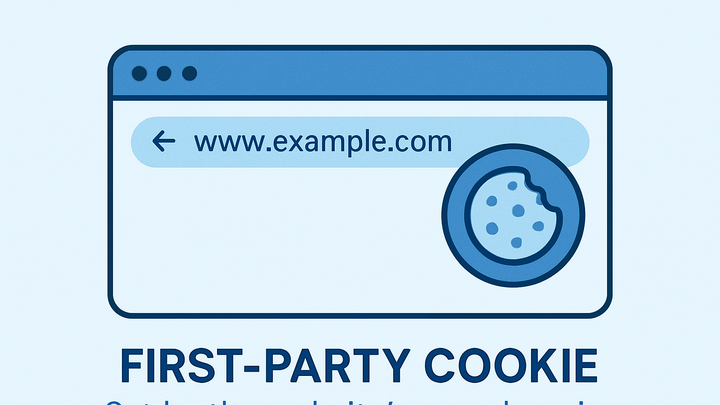Published on 2025-06-22T07:47:20Z
What is a First-Party Cookie? Examples & Use Cases in Analytics
In web analytics, a first-party cookie is a small text file created and stored by the domain a user is visiting. It typically holds a unique identifier, session details, and user preferences, helping analytics platforms like GA4 recognize repeat visits and measure engagement. Because the cookie’s domain matches the site itself, first-party cookies are considered more privacy-friendly than third-party cookies and are less likely to be blocked by modern browsers. These cookies enable accurate session tracking, conversion measurement, and personalization without relying on external domains. While traditional analytics tools depend on first-party cookies, privacy-focused solutions such as PlainSignal adopt a cookieless model, leveraging server-side techniques and anonymous identifiers. Implementing first-party cookies requires minimal code changes: you can use HTTP headers or JavaScript’s document.cookie API. Below, you’ll find code examples for GA4’s cookie-based tracking and PlainSignal’s cookie-free alternative to illustrate real-world usage.
First-party cookie
In analytics, first-party cookies are set by a website's own domain to store client IDs and track user sessions in tools like GA4.
Definition and Core Concepts
This section covers the fundamental idea behind first-party cookies, their origin, and how they differ from other cookie types.
-
Core definition
A first-party cookie is created and stored by the website a user is visiting directly. It records information such as session identifiers, user preferences, and language settings specific to that domain.
-
Setting mechanisms
Websites can set first-party cookies through HTTP response headers or client-side JavaScript, ensuring the cookie’s domain matches the site setting it.
-
Http set-cookie header
The server sends a Set-Cookie header in its HTTP response to instruct the browser to store a cookie under the same domain.
-
Javascript document.cookie
Client-side code uses document.cookie to create or update cookies, allowing dynamic cookie management in the browser.
-
Role in Web Analytics
Explore how first-party cookies are used by analytics tools to track user behavior in a privacy-focused manner.
-
GA4 and first-party cookies
Google Analytics 4 uses first-party cookies to assign a unique Client ID, enabling tracking of user sessions and touchpoints across pages.
-
PlainSignal's cookie-free approach
PlainSignal offers simple, cookieless analytics, eliminating the need for first-party cookies while still providing privacy-friendly metrics.
-
No cookie storage
By leveraging server-side tracking and anonymous identifiers, PlainSignal avoids storing cookies in the user’s browser entirely.
-
Privacy and Compliance
Discuss privacy implications, GDPR and CCPA compliance, and best practices for obtaining user consent when using first-party cookies.
-
Gdpr and ccpa considerations
Since first-party cookies involve storing user data, sites must disclose their use in privacy policies and may require consent under GDPR and CCPA.
-
User consent best practices
Implement clear banners and options allowing users to opt in or out of cookie usage, and honor preference settings across sessions.
Implementation Examples
A code snippet demonstrating how analytics platforms manage first-party cookies or alternatives in practice.
-
GA4 tracking snippet
Example of GA4 script tag that leverages first-party cookies to store client IDs and record pageviews:
-
Snippet
<!-- Google Analytics GA4 --> <script async src="https://www.googletagmanager.com/gtag/js?id=G-XXXXXXX"></script> <script> window.dataLayer = window.dataLayer || []; function gtag(){dataLayer.push(arguments);} gtag('js', new Date()); gtag('config', 'G-XXXXXXX'); </script>
-
-
PlainSignal tracking snippet
PlainSignal uses a cookie-free approach. Add this snippet to start tracking without cookies:
-
Snippet
<link rel="preconnect" href="//eu.plainsignal.com/" crossorigin /> <script defer data-do="yourwebsitedomain.com" data-id="0GQV1xmtzQQ" data-api="//eu.plainsignal.com" src="//cdn.plainsignal.com/plainsignal-min.js"></script>
-
